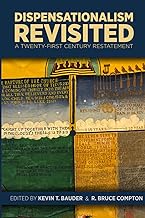A review of Dispensationalism Revisited: A Twenty-First Century Restatement, edited by Kevin T. Bauder & R. Bruce Compton, Plymouth, MN, Central Seminary Press, 2023, 294 pages, paperback.
This book was written to commemorate the life and teaching of Charles A. Hauser, Jr, a man who did not have a high profile ministry but who had a big impact through his faithful service to the Lord, and the tributes at the back of the book are not to be missed.
Dispensationalism Revisited is slanted toward traditional dispensationalism, although some contributors are sympathetic towards progressive dispensationalism (13). The editors say they wanted the book to be readable (15), but that academics would also read it. They explain that the first three chapters are “the heart of the book” (15); chapter 1 on the Sine Qua Nons; chapter 2 on hermeneutics; and chapter 3 on Israel and the Church. These chapters comprise the first hundred pages of the book.
The first chapter is written by Douglas Brown on Dispensationalism’s sine qua nons, and in particular the glory of God, which was famously propounded by Charles Ryrie in the mid 1960’s. The essay puts forth seven premises to prove the importance of the doxological purpose within Dispensationalism. Although there is nothing earth-shaking about any of the premises, Brown unpacks then adequately. He notes “If God called creation to seek something other other than his own glory, he would be calling people to idolatry.” (23). The piece does not persuade me that the glory of God is a sine qua non of Dispensationalism. That is to say, it does not prove that God’s glory is an essential component or outcome of the system. In fact, only premises four, six, and seven are weighty enough when tied to Dispensationalism to have any force for the argument.
But here it might be argued that I am confusing that which dispensationalists have traditionally highlighted with what the system when stepped back from is seen to produce. To this I will concede that although dispensationalists have not very often lent prominence to God’s glory in their setting out of the system, Dispensationalism itself could be understood as a picture of how God glorifies Himself in the history of our fallen world. But this would be saying something different from pointing to the literal hermeneutic or the Israel-Church distinction. Those are intrinsic ingredients in the system. The glory of God is different. It is a feature of any theological system which takes Scripture seriously (cf. 31), some more than others. And in this sense Covenant Theology takes the laurels owing to its redemptive hermeneutic and theological telos.
Brown believes “God has chosen to reveal himself progressively in each dispensation.” (26). He provides a brief synopsis of this (26-27), but these are more singular instances than dispensational markers. Even the coming of Christ does not institute a new dispensation according to Dispensationalism. This is the kind of thing I mean when I assert that dispensations are shaky pillars upon which to rest a theological system. In truth, although it may invite brickbats to come my way I don’t think the arguments for the doxological purpose being a sine qua non are that convincing.
The second chapter is by Roy Beacham and is on the interpretation of the Prophets. Before I gush over this essay I should state that it just barely meets the standard of readability that the editors promised. It is rather stiffly academic and the word choices (hermeneutical rubrics, delimitations, preunderstanding, biblically perspicuous, apogee) do stretch the brief a little. For instance, what “common reader” would easily digest the following: “It seems apparent that the only impetus to forward such a drastic and non-self-evident bifurcation of this otherwise unified prophecy would find cause in theological preunderstandings and ensuing hermeneutical complexities that are forced upon the text from without.” (48)? So Beacham doesn’t get any plaudits on that score.
However, as a study in biblical hermeneutics Beacham’s article is one of the best pieces I have read on the topic. He writes that “Historic dispensationalism…believes that all the predictive prophecies of Scripture were meant by God to be understood, fulfilled, and thus interpreted literally and only literally, exactly as foretold” (35). Beacham proposes five reasons for this: the purpose, ground, nature, function, and test of predictive prophecy (37). Providing examples from the Book of Isaiah (reproduced for the reader to follow) he shows that God intended prophecy to validate Him as the only true God, but this only checks out if “everything that God foretells actually comes to pass precisely as foretold” (40). (This is the ‘God’s speech/God’s actions’ correspondence I have referred to elsewhere – cf. also 50).
By the ground of predictive prophecy the writer has in mind the connection between what God says will come to pass and His essential holy and faithful character (42). He sums it up in a tidy maxim: “Exactly what he says is precisely what he does because of who he is” (43). That is worth committing to memory. Beacham takes his time on this point and I find him very persuasive. He concludes, “Deviant fulfillment, would, in fact, disprove his singularity and discount his perfections” (51 his emphasis).
Moving on to the nature of prophecy Beacham insists it was univocal (51), while its unitary nature does not posit a disconnect between divine and human authorship; in fact, it is the divine element in prophecy that ought to be given the precedence (54-55). Deuteronomy 18:15-22 is used to drive this point home. Divine propositions do not alter their meaning with the passage of time (56). This text also helps to define the function of predictive prophecy (60). He states,
“If the original hearers were responsible to understand and to believe God’s forecasts and to live in constant and obedient faith in the words of those forecasts, then God’s forecasts needed no intricate, sophisticated hermeneutical overlay” (61). Any attempts to commend a shadow-to-substance meaning “leaves OT saints in revelatory limbo” (62 n. 58).
Finally the test of predictive prophecy just correlates the accuracy of the human prophet’s words with their fulfillment (64-65). It is a “test by outcome” (66). The essay ends with Beacham summarizing his points and pressing their cumulative weight:
“It seems doubtful that God intended sophisticated literary theories, complex hermeneutical schemes, and/or classical theological preconditions to supersede both his clear instructions for this genre and its undeniable outworking in antiquity.” (69).
Throughout the essay the author interacts in footnotes with non-literal interpreters to shore up his arguments. I do not agree with Beacham’s position on the New covenant not being for the Church (49), but I do think he has hit the nail squarely on the head in all other respects. This is an excellent piece of writing and deserves to be expanded into a small book in its own right.




